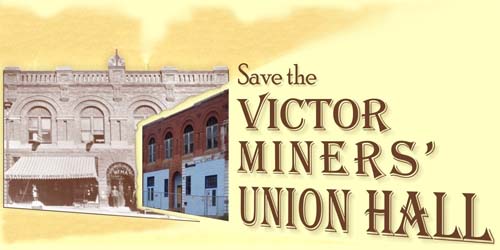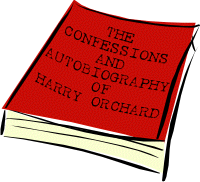 |
Victor
|
THE CONFESSIONS AND AUTOBIOGRAPHY
OF
HARRY ORCHARD

Webmaster's Introduction
Harry Orchard was known by so many aliases that he sometimes got them confused. The cold hearted assassin was, by his own words, unconcerned about who, or how many, he killed with dynamite bombs — the so-called "infernal machines" — that he invented.
A cruel and calculating opportunist, Orchard was accused of working for both sides in the bloody struggle that came to be called the Colorado Labor Wars.
Orchard was a member of, and drew strike benefits from the Western Federation of Miners. According to his own account after his capture, he was also employed by the union leadership as a paid assassin. He also admitted to being employed briefly and — according to others — was possibly employed for much longer by the Mine Owners' Association and their business associates, the Pinkerton Detective Agency. The union aimed to win a strike. The Mine Owners' Association and the Pinkertons sought to crush the union that called that strike. In the meantime, dozens of lives were lost, many of them undoubtedly at Harry Orchard's hands.
Here is the fascinating, intended-for-public-consumption version of Harry Orchard's story, penned and first released while he was awaiting trial for assassinating Frank Steunenberg, the former governor of Idaho.
Why did Harry Orchard write this account? What did he have to gain from a public confession? Chapter eighteen offers his explanation, but it doesn't tell the whole story.
Pinkerton Detective James McParland, the agent who infiltrated the Molly Maguires (resulting in the executions of nineteen men), was put in charge of investigating former Governor Steunenberg's assassination. McParland threatened to hang Harry Orchard unless he confessed and implicated union leaders in doing so. (See an account of Agent McParland and the Molly Maguires in The Pinkerton Labor Spy. For additional background, the book Roughneck by Peter Carlson gives a persuasive analysis of Detective McParland's alleged entrapment methods.)
It seems that Orchard's every step after capture was orchestrated by Detective McParland, who used kidnapping, manipulation, publicity, and propaganda (including releasing Orchard's confession as a magazine serial) to make the downfall of the WFM leadership seem imminent and inevitable.
Facing the near certainty of a death sentence, Orchard complied with full and submissive cooperation, even to the extent of embracing religion in prison. He flung open a public window onto his secretive life of deception, theft, murder, arson, and general mayhem.
However, a full century after these turbulent events, we still don't know whether Harry Orchard's conversion to Christianity or his widely publicized account of history were honest and heartfelt, or yet another cynical ploy to curry favor with his captors.
Orchard's telling of his life story, developed in prison over a period of fifteen months, seemed consistent and unshakeable in the courtroom. Yet given the legal framework of the period, juries in several different venues were not sufficiently persuaded. Every one of Orchard's alleged co-conspirators in the Western Federation of Miners went free: Secretary-Treasurer Bill Haywood was found not guilty. Union supporter George Pettibone, in a separate trial, likewise. Miner Steve Adams was tried twice in Idaho and once in Colorado, yet none of the three juries found him guilty. WFM President Charles Moyer was held in prison, but was never tried.
Only Harry Orchard was found guilty of the assassination of Governor Steunenberg. He was subsequently sentenced to death in March of 1908. When his death sentence was about to be commuted, he asserted that avoiding a public hanging was not his goal. In letters he sent to the Steunenberg family, he claimed a preference for the death penalty.
To this day, Harry Orchard remains a contradiction and a mystery. Here is his accounting of his life and deeds.
READ: My Earliest Life In Ontario